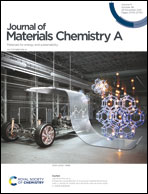AlCl3-graphite intercalation compounds as negative electrode materials for lithium-ion capacitors†
Abstract
Lithium-ion capacitors (LICs) are energy storage devices that bridge the gap between electric double-layer capacitors and lithium-ion batteries (LIBs). A typical LIC cell is composed of a capacitor-type positive electrode and a battery-type negative electrode. The most common negative electrode material, graphite, suffers from low rate capability and cyclability due to the sluggish kinetics of the Li+ intercalation/de-intercalation process. In this work, metal chloride-pillared graphite, which has recently attracted attention as high-rate LIB anodes, is applied as the negative electrode for LICs for the first time to overcome this drawback. It is shown that AlCl3-graphite intercalation compounds (AlCl3-GICs) with a wide interlayer spacing benefit faster Li+ diffusion. The low molecular weight and conversion reaction of the AlCl3 pillar further enhance the specific capacity per mass. An optimized LIC cell composed of an AlCl3-GIC negative electrode and activated carbon as the positive electrode exhibited higher energy and power densities compared to LICs using graphite as the negative electrode, and displayed stable cycling performance with 85% capacity retention after 10 000 charge/discharge cycles. The AlCl3-GICs synthesized in this work displayed improved electrochemical performances and have the potential to replace the graphite electrode in conventional LICs.



 Please wait while we load your content...
Please wait while we load your content...